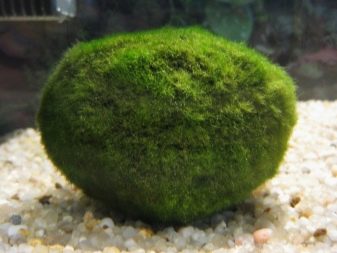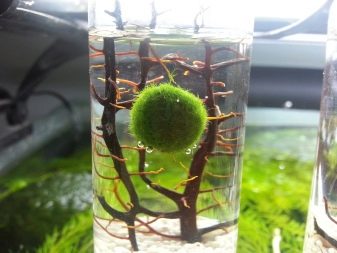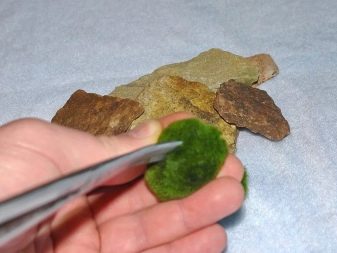Kladofora spherical - a plant popular in the world of aquariums, which attracts lovers of home artificial ponds with its unusual shape. In addition, this is a rather picky representative of the flora, although it requires compliance with certain maintenance rules.


Plant description
In nature, culture grows in Eurasia, it can often be found on islands located near the mainland. In the natural environment, the plant prefers to develop in cool reservoirs with a weakened flow. The densest specimens can be seen in the lakes on the Japanese island of Hokkaido and in the northern part of Iceland.
This plant is a a type of algae that, under certain conditions, can take the form of a ball. This is not a higher aquatic plant and not moss, although for the sake of simplicity the syllable is sometimes called aquarium moss.
The formed ball has a dense structure and a perfectly round silhouette. In general, this phenomenon is formed due to the connection of several instances of cladophores. Plants intertwine and form a spherical shape.


The surface of the ball looks like a moss of bright green or dark green color. If a brown or yellowish precipitate is observed, then it can be assumed that the culture is contained in adverse conditions.
Inside the ball is also green. The plants from which it is composed have a radial direction, which forms the basis of the design. The inner layer contains chloroplasts that are at rest. If the ball is divided, then the chloroplasts will take an active state. In balls formed by old plants, the interior is completely hollow.
Culture, like other representatives of lower algae, has no roots, and thanks to this, the life of the ball is very interesting to observe. So, the daily cycle is divided into two stages: in the morning, moss is at the bottom, and floats to the surface in the afternoon and evening. Observation of the process allows the aquarist to admire the beauty of a natural phenomenon. This feature is explained by the fact that in the mossy upper layer many oxygen bubbles collect, which force the plant to float. On the surface, the bubbles disappear and the ball returns to the bottom again.
In diameter, one such figure is usually 8-12 cm. Development and growth time is determined by the temperature of the water.
The plant develops well both in a natural body of water and in a home aquarium.


Growing conditions
As a rule, aquarists do not like to grow lower algae - they pollute the capacity and can negatively affect the health of fish. But the peculiarity of the cladophore is that it has the inverse properties. The formed ball is able to clean water and enrich it with oxygen. In addition, such an interesting phenomenon in the aquarium looks very unusual in aesthetic terms.
However, for the full development of this biological filter several rules must be followed. First of all, pay attention to the water indicators. Culture will grow well with acidity 4-6, hardness up to 7 units and at a temperature of 22 degrees. If the temperature rises, then the ball begins to grow ugly and unevenly, deform. Having seen this phenomenon, it is necessary to lower the water temperature for a month - during this time the ball will return to its previous neat shape.
In addition, the plant prefers to develop in clean water, therefore every week should replace 1/3 of the volume of the aquarium. Be sure to equip the tank external or internal filter.
It is undesirable when growing the culture to allow excessively bright lighting, as this threatens the accumulation of oxygen bubbles. Lighting should illuminate the aquarium moderate, restrained light.


Proper care
If the aquarist noticed that the ball was covered with a dark brown coating, then we can assume that he needs to rinse. You can rinse the cladophore in cool water, and then squeeze a little water. This procedure is able to return the plant a beautiful rich green color.
If the alga has taken a different shape, then it is periodically rolled so that it again becomes spherical. Some aquarists make carpets for aquariums from plants, cutting them and giving the figure the desired shape. To do this, separate the moss and crush each part so that it becomes flat.
After that, the resulting halves are fixed on stones or soil with fishing line.


Sometimes the plant grows so much that thinning is required. To eliminate unnecessary instances, they are removed mechanically. Also, to maintain the right amount, shrimp are planted in the aquarium.
When caring for a plant, it is important to monitor its condition, sometimes it indicates problems in the maintenance of the entire aquarium world. The following signs should alert you.
- The ball has lost its brightness. This may indicate a violation of the water or an excess of lighting.
- The formation of light or yellow fibers from one part can talk about inadequate flow. In such a situation, the plant is turned over.
- Deformation indicates an increase in temperature. It also leads to proliferation. Solving the problem will help to eliminate the excess and control the thermostat.
- Black spots or spontaneous decay indicates a putrefactive process or death of a plant. Using healthy fibers, the colony can be restored again.



Compatibility
Kladofora is not only a natural filter for the aquarium, but also a source of nutrients for aquarium inhabitants.For example, shrimps like to feast on this seaweed, therefore they are often grown in small quantities in one container with the presented culture. You can place the ball in the caddy with fry: ciliates accumulate on the fibers, which can become a complete food for the cubs.
When choosing a neighborhood, keep in mind that the cladophore will not develop normally in warm water, which means that its potential neighbors will have to be kept at 22 degrees. Not the most favorable neighbors will be catfish, crayfish, goldfish. These creatures quickly swallow a plant.


How does it breed?
You can plant mosses vegetatively in two ways:
- in a natural way;
- in an artificial way.
In nature, the cladophore multiplies with increasing temperature to 26 degrees. The process looks like the decomposition of spherical moss into several parts, from which fresh colonies are formed.
Artificial reproduction is as follows:
- first, the aquarist raises the temperature of the water by 2-3 degrees;
- then a medium-sized fragment is separated from the ball;
- the resulting share is planted in a separate container.


Do not wait for operational growth from a potential future ball.
Annual growth is only 10 mm, and at temperatures up to 20 degrees - 5 mm. A full-fledged ball is formed after 1-2 years. If the aquarist is patient and wants to become the owner of a large ball with a diameter of 20 cm, he will have to wait for 15 years.
Most aquarists do not want to spend time on such a long process as breeding cladophores, but prefer to buy new items in pet stores. The plant is offered in almost every department for animals and is very inexpensive.
About what distinguish features of spherical cladophores, see the next video.










